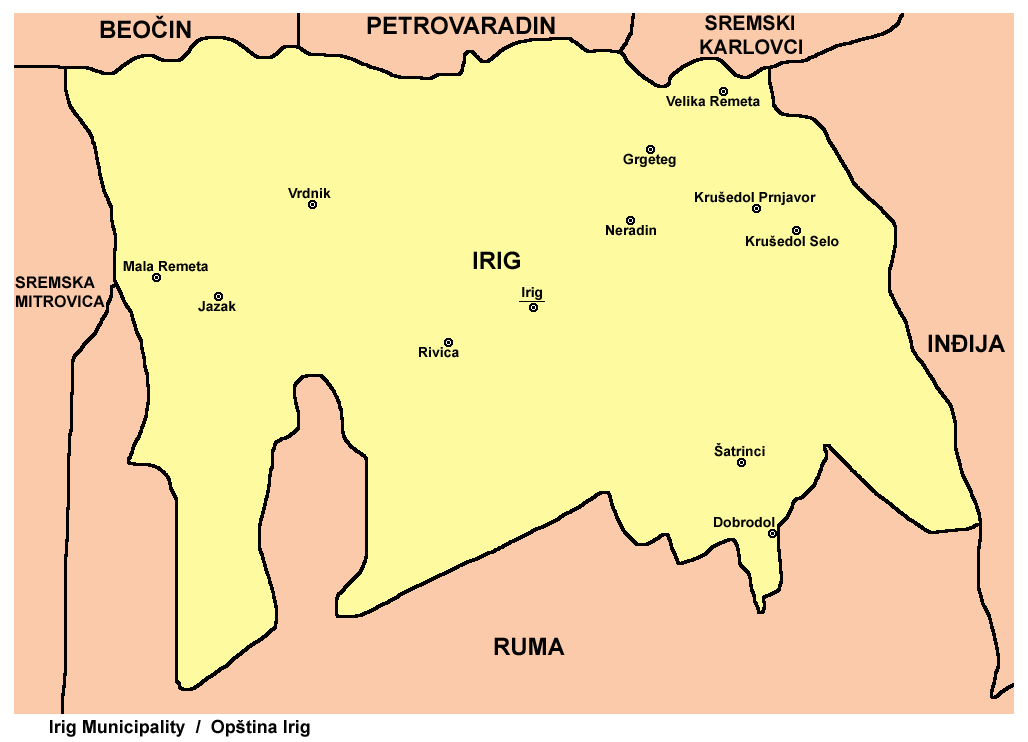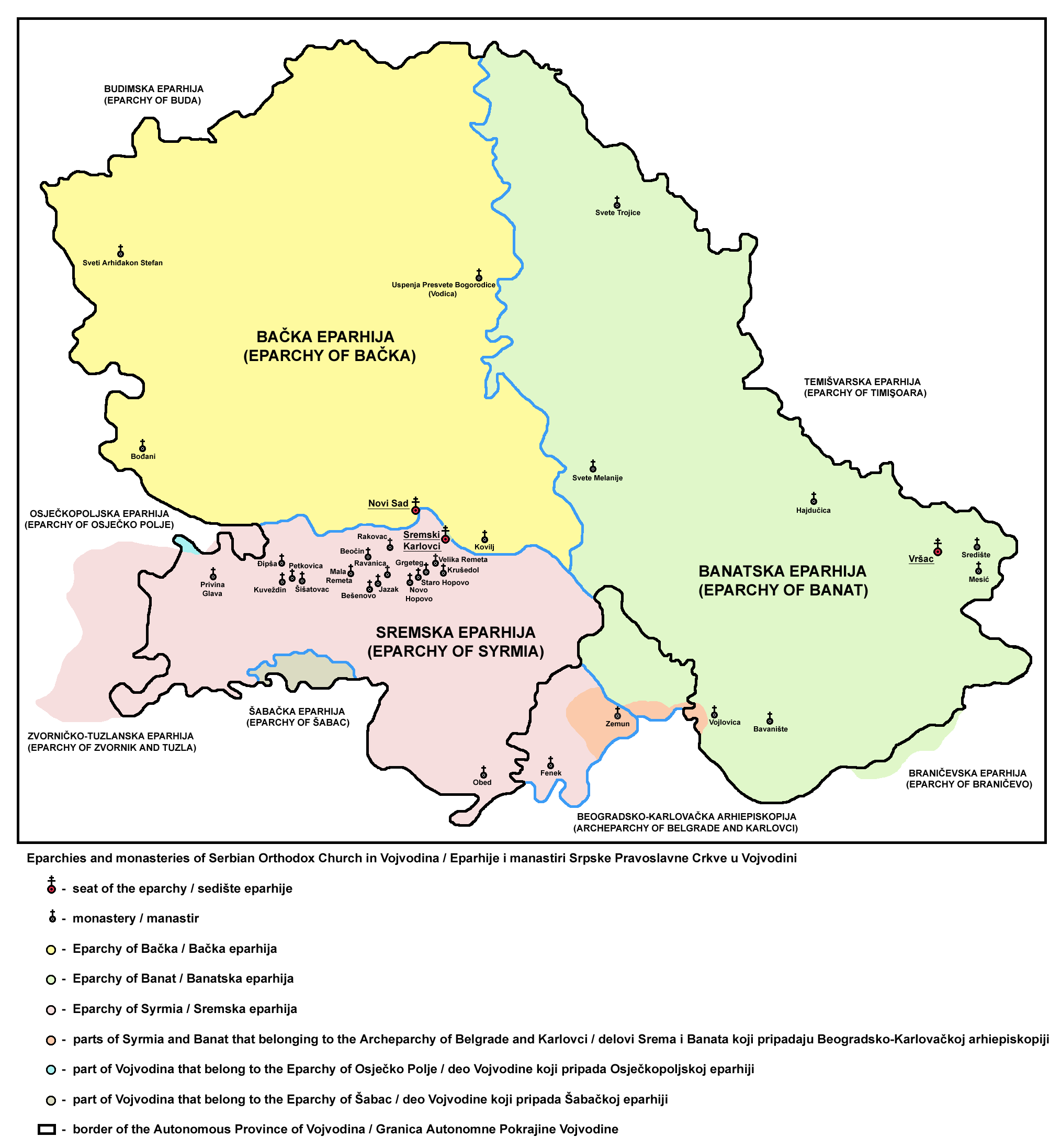|
Grgeteg
Grgeteg () is a village in Serbia. It is situated in the Irig municipality, in the Srem District, Vojvodina province. The village has a Serb ethnic majority among its population of 76, according to the 2011 census. Grgeteg is home to the Grgeteg Monastery, one of the sixteen monasteries on the Fruška Gora mountain. Geography Grgeteg is located in the region of Syrmia, on the southern slopes of Fruška Gora. The village is situated in the northeast of the municipality of Irig, on the Kalin creek. Its territory extends for , with a median altitude of above sea level. It is the least densely populated place in Vojvodina. Grgeteg is located from Novi Sad, from Irig, and from Ruma. History The history of the village is closely tied to the Grgeteg Monastery, which was founded in the 15th century. The village itself was developed in the 18th century as a , a rural village inhabited by serfs who were dependent on the religious institution. According to tradition, the monas ... [...More Info...] [...Related Items...] OR: [Wikipedia] [Google] [Baidu] |
Immovable Cultural Heritage Of Exceptional Importance (Serbia)
Immovable Cultural Heritage of Exceptional Importance ( sr, Непокретна културна добра од изузетног значаја/) are those objects of Immovable Cultural Heritage of Serbia, cultural heritage that enjoy the highest level of state protection in the Republic of Serbia. Immovable Cultural Heritage is classified as being of Exceptional Importance upon decision by the National Assembly of Serbia. They are inscribed in the ''Central Register of Immovable cultural property'' maintained by the Institute for the Protection of Cultural Monuments of Serbia. Objects of Immovable cultural heritage have to fulfill one or more of those criteria defined in the ''Law on Cultural Heritage'' of 1994 in order to be categorized as being "of exceptional importance": # exceptional importance for social, historical or cultural development of the people, or for the development of its natural environment; # evidence of important historic events or persons and their work; # ... [...More Info...] [...Related Items...] OR: [Wikipedia] [Google] [Baidu] |
Irig, Serbia
Irig (, ; hu, Ürög) is a town and municipality located in the Srem District of the autonomous province of Vojvodina, Serbia. The town has a population of 4,415, while Irig municipality has 10,866 inhabitants. Name In Serbian, the town is known as ''Irig'' (Ириг), in Croatian as ''Irig'', in Hungarian as ''Ireg'' or ''Ürög'', in German as ''Irick'', in Slovak as ''Irig'', and in Rusyn as Ириґ. History Irig was first mentioned in the historical documents in 1225. In the 15th century, the masters of the town were Serbian despots Vuk Grgurević, Đorđe Branković, and Jovan Branković. During the 15th and 16th century, ten Orthodox monasteries were built in the surrounding of Irig (Two of those were located just near the town). Between 1526 and 1699, the town was under Ottoman administration. During this time, it belonged to the Sanjak of Syrmia, and was the administrative seat of one of the seven nahijas in that sanjak. In 1665, the town had 2,000 houses, one m ... [...More Info...] [...Related Items...] OR: [Wikipedia] [Google] [Baidu] |
List Of Serbian Orthodox Monasteries
This is a list of Serbian Orthodox Christian monasteries in Serbia and near areas (Montenegro, Bosnia and Herzegovina, Croatia, North Macedonia, and Kosovo), also Romania, Hungary, Greece, Germany, United States of America, Canada, and Australia. Stauropegions There are two stauropegion monasteries in the Serbian Orthodox Church, that are directly subordinated to the Serbian patriarch: Archeparchy of Belgrade and Karlovci Source Eparchy of Srem Source Eparchy of Banat Source Eparchy of Bačka Eparchy of Šabac Source Eparchy of Valjevo Source Eparchy of Šumadija Source Eparchy of Vranje Source Eparchy of Timok Source Eparchy of Kruševac Source Eparchy of Žiča Source Eparchy of Niš Source: https://eparhijaniska.rs/manastiri Eparchy of Braničevo Eparchy of Mileševa Source In Serbia In Montenegro Eparchy of Raška and Prizren, Eparchy of Ras and Prizren Source In Central Serbia In Kosovo Metropolitan ... [...More Info...] [...Related Items...] OR: [Wikipedia] [Google] [Baidu] |
Fruška Gora
Fruška gora ( sr-Cyrl, Фрушка гора; hu, Tarcal-hegység) is a mountain in Syrmia, administratively part of Serbia with a part of its western side extending into eastern Croatia. The area under Serbian administration forms the country's oldest national park. Sometimes also referred to as the ''Jewel of Serbia'', due to its largely pristine landscape and protection effort, or the ''Serbian Mount Athos'', being the home of a large number of historical Serbian Orthodox monasteries. Name In Serbian, it is known as ''Fruška gora'' (, Фрушка гора), in Hungarian as ''Tarcal'' (also ''Almus-hegy'' or ''Árpatarló''), in German as ''Frankenwald'', and in Latin as ''Alma Mons''. In Medieval Greek, it was known as ''Frangochoria''. The mountain's name originates in the old Serbian word ''"Fruzi"'' derived from the singular form ''"Frug"''; and its adjective is ''Fruški'', used for naming the Frankish people. The name of ''"Fruška Gora"'' is ''"Frankish mountai ... [...More Info...] [...Related Items...] OR: [Wikipedia] [Google] [Baidu] |
Vuk Grgurević
Vuk Grgurević Branković ( sr-cyrl, Вук Гргуревић Бранковић; ca. 1439 – April 16, 1485) was a Serbian nobleman who was the titular despot of Serbia from 1471 until his death in 1485. He inherited the title of '' despot'' (as an heir to the throne now under the occupation of the Ottoman Empire), by King Matthias Corvinus, and ruled most of present-day Vojvodina, under the overlordship of the Kingdom of Hungary. He is known in Serbian epic poetry for his valour and heroism, and is called Vuk the Fiery Dragon ( sr, Змај Огњени Вук / ''Zmaj Ognjeni Vuk''), Vuk the Dragon-Despot, or simply the Dragon; he commanded the Hungarian army ('' Black Army'') in several of its battles against the Ottomans. He is considered the founder of Grgeteg monastery. Life Vuk was the son of Grgur Branković, and a grandson of despot Đurađ Branković and Eirene Kantakouzene. His father Grgur was blinded by the Ottomans in 1441. With the fall of Serbian Despotate ... [...More Info...] [...Related Items...] OR: [Wikipedia] [Google] [Baidu] |
Srem District
The Srem District ( sr, / , ) is one of seven administrative districts of the autonomous province of Vojvodina, Serbia. It lies in the geographical regions of Syrmia and Mačva. According to the 2011 census results, it has a population of 312,278 inhabitants. The administrative center is the city of Sremska Mitrovica. Name In Serbian, the district is known as ''Sremski okrug'' (), in Croatian as ''Srijemski okrug'', in Hungarian as ''Szerémségi Körzet'', in Slovak as ''Sriemskí okres'', in Rusyn as ''Srimski okruh'' (Сримски окрух), and in Romanian as ''Districtul Srem''. Administration The Srem District is one of seven districts (first-level administrative divisions) of Vojvodina (and 29 of Serbia). Districts are regional centers and do not have any form of self-government. The District includes the municipalities of: * Inđija * Irig * Pećinci * Ruma * Sremska Mitrovica * Stara Pazova * Šid History In Late antiquity, between the 3rd and 5th centu ... [...More Info...] [...Related Items...] OR: [Wikipedia] [Google] [Baidu] |
List Of Places In Serbia
This is the list of populated places in Serbia (excluding Kosovo), as recorded by the 2002 census, sorted alphabetically by municipalities. Settlements denoted as "urban" (towns and cities) are marked bold. Population for every settlement is given in brackets. The same list in alphabetic order is in List of populated places in Serbia (alphabetic). A Ada Aleksandrovac Aleksinac Alibunar Apatin Aranđelovac Arilje B Babušnica Bač Bačka Palanka Bačka Topola Bački Petrovac Bajina Bašta Barajevo Batočina Bečej Bela Crkva Bela Palanka Beočin Blace Bogatić Bojnik Boljevac Bor Bosilegrad Brus Bujanovac C Crna Trava Č Čačak Čajetina Čoka Čukarica Ć Ćićevac Ćuprija D Despotovac Dimitrovgrad Doljevac G Gadžin Han Golubac Gornji Milanovac Grocka I Inđija Irig Ivanjica J Jagodina K Kanjiža Kikinda Kladovo Knić Knjaževac Koceljeva Kosjerić Kovačica Kovi ... [...More Info...] [...Related Items...] OR: [Wikipedia] [Google] [Baidu] |
List Of Cities, Towns And Villages In Vojvodina
This is a list of cities, towns and villages in Vojvodina, a province of Serbia. List of largest cities and towns in Vojvodina List of urban settlements in Vojvodina List of all urban settlements (cities and towns) in Vojvodina with population figures from recent censuses: South Bačka District: West Bačka District: North Bačka District: North Banat District: Central Banat District: South Banat District: Syrmia District: The inhabited places of South Bačka District City of Novi Sad – Novi Sad Municipality Hamlets and suburbs: * Bangladeš (Бангладеш) * Kamenjar (Камењар) * Lipov Gaj (Липов Гај) * Nemanovci (Немановци) * Pejićevi Salaši (Пејићеви Салаши) City of Novi Sad – Petrovaradin Municipality Bač Municipality Hamlets and suburbs: * Labudnjača (Лабудњача) * Mali Bač (Мали Бач) * Živa (Жива) Bačka Palanka Municipality Bački Petrovac Municipalit ... [...More Info...] [...Related Items...] OR: [Wikipedia] [Google] [Baidu] |
List Of Populated Places In Serbia
This is the list of populated places in Serbia (excluding Kosovo), as recorded by the 2002 census, sorted alphabetically by municipalities. Settlements denoted as "urban" (towns and cities) are marked bold. Population for every settlement is given in brackets. The same list in alphabetic order is in List of populated places in Serbia (alphabetic). A Ada Aleksandrovac Aleksinac Alibunar Apatin Aranđelovac Arilje B Babušnica Bač Bačka Palanka Bačka Topola Bački Petrovac Bajina Bašta Barajevo Batočina Bečej Bela Crkva Bela Palanka Beočin Blace Bogatić Bojnik Boljevac Bor Bosilegrad Brus Bujanovac C Crna Trava Č Čačak Čajetina Čoka Čukarica Ć Ćićevac Ćuprija D Despotovac Dimitrovgrad Doljevac G Gadžin Han Golubac Gornji Milanovac Grocka I Inđija Irig Ivanjica J Jagodina K Kanjiža Kikinda Kladovo Knić Knjaževac Koceljeva Kosjerić Kovačica Kovi ... [...More Info...] [...Related Items...] OR: [Wikipedia] [Google] [Baidu] |
Wheat
Wheat is a grass widely cultivated for its seed, a cereal grain that is a worldwide staple food. The many species of wheat together make up the genus ''Triticum'' ; the most widely grown is common wheat (''T. aestivum''). The archaeological record suggests that wheat was first cultivated in the regions of the Fertile Crescent around 9600 BCE. Botanically, the wheat kernel is a type of fruit called a caryopsis. Wheat is grown on more land area than any other food crop (, 2014). World trade in wheat is greater than for all other crops combined. In 2020, world production of wheat was , making it the second most-produced cereal after maize. Since 1960, world production of wheat and other grain crops has tripled and is expected to grow further through the middle of the 21st century. Global demand for wheat is increasing due to the unique viscoelastic and adhesive properties of gluten proteins, which facilitate the production of processed foods, whose consumption is inc ... [...More Info...] [...Related Items...] OR: [Wikipedia] [Google] [Baidu] |
Corn
Maize ( ; ''Zea mays'' subsp. ''mays'', from es, maíz after tnq, mahiz), also known as corn (North American and Australian English), is a cereal grain first domesticated by indigenous peoples in southern Mexico about 10,000 years ago. The leafy stalk of the plant produces pollen inflorescences (or "tassels") and separate ovuliferous inflorescences called ears that when fertilized yield kernels or seeds, which are fruits. The term ''maize'' is preferred in formal, scientific, and international usage as a common name because it refers specifically to this one grain, unlike ''corn'', which has a complex variety of meanings that vary by context and geographic region. Maize has become a staple food in many parts of the world, with the total production of maize surpassing that of wheat or rice. In addition to being consumed directly by humans (often in the form of masa), maize is also used for corn ethanol, animal feed and other maize products, such as corn starch and ... [...More Info...] [...Related Items...] OR: [Wikipedia] [Google] [Baidu] |







